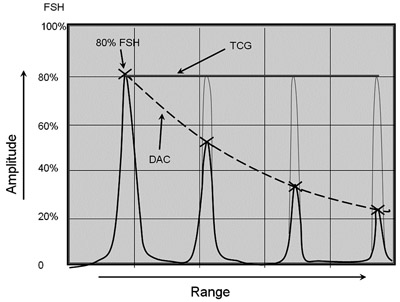TCG
Time-Corrected Gain
TCG – Time-Corrected Gain is a method of compensating for a reduction in signal amplitude with increasing range from reflectors of equal area. This is achieved by increasing the system gain with time so that the signals appear of equal amplitude. TCG achieves the same objective as a DAC.
The DAC is generated by plotting the amplitude of a known calibration reflector at different distances from the probe whilst the gain setting on the flaw detector is maintained constant. The DAC is plotted on the screen through these amplitudes – see Figure. Any additional gain is then added and indications that break the curve during the inspection are investigated.

With TCG, the gain of the flaw detector is adjusted with time so that the echo height of a calibration reflector at any position along the time base will be the same. So, the DAC is converted into a straight horizontal line on the flaw detector – see Figure.
When using a DAC, the signals at greater distances are a smaller percentage of the FSH than those nearer the probe. The use of TCG means that all the signals requiring evaluation are at the same %FSH on the flaw detector screen, no matter at what distance they appear.
Another benefit of TCG is that the evaluation of indications can be easily supported by the use of a monitor gate on the flaw detector and the amplitude of the indication above the threshold displayed.
What the hec?! articles are not intended to be the definitive account on the topic or acronym in question. Readers’ comments and contributions are welcomed. Email: ndtnews@bindt.org
The DAC is generated by plotting the amplitude of a known calibration reflector at different distances from the probe whilst the gain setting on the flaw detector is maintained constant. The DAC is plotted on the screen through these amplitudes – see Figure. Any additional gain is then added and indications that break the curve during the inspection are investigated.

With TCG, the gain of the flaw detector is adjusted with time so that the echo height of a calibration reflector at any position along the time base will be the same. So, the DAC is converted into a straight horizontal line on the flaw detector – see Figure.
When using a DAC, the signals at greater distances are a smaller percentage of the FSH than those nearer the probe. The use of TCG means that all the signals requiring evaluation are at the same %FSH on the flaw detector screen, no matter at what distance they appear.
Another benefit of TCG is that the evaluation of indications can be easily supported by the use of a monitor gate on the flaw detector and the amplitude of the indication above the threshold displayed.
What the hec?! articles are not intended to be the definitive account on the topic or acronym in question. Readers’ comments and contributions are welcomed. Email: ndtnews@bindt.org